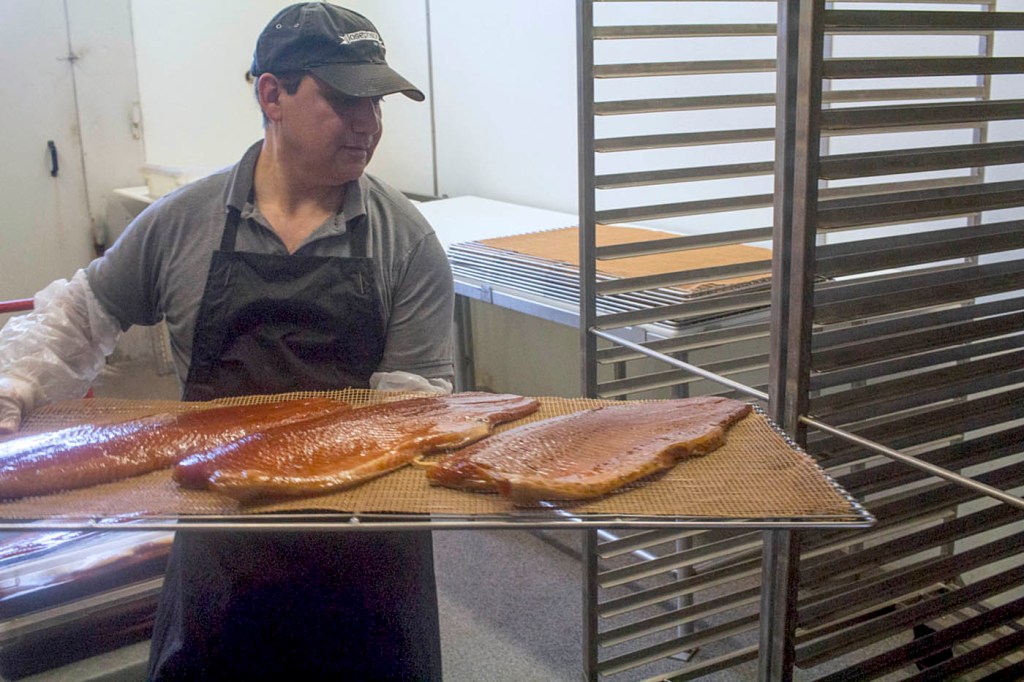Local flavor drives coastal tourism
Published 4:41 pm Wednesday, June 12, 2019

- Julio Layola loads wine maple-marinated Atlantic salmon fillets for cold-smoking into lox at Josephson's Smokehouse.
Tourists who visit the coast and other summer destinations often want to leave with a taste of Oregon.
Travel Oregon surveyed people who visited Oregon in the past year to see if they were purchasing more of the state’s products, said Todd Davidson, CEO of the travel promotion group.
More than half had gone out of their way to buy products made in the state, from chocolate and cheese to wine, beer and seafood. More than 40 percent had shared the products with friends and relatives back home.
“A similar number believed these products would now be encouraging their friends and relatives to now consider Oregon for a future vacation destination,” Davidson said. “So, where one time you have vacation driving demand for the product, now you’ve got the product, once they’re back home, becoming the promotion, that chance to try Oregon seafood or Oregon craft beer.”
Sharing local flavor
Michael Josephson is the third-generation owner of Josephson’s Smokehouse in Astoria, started in 1920. The smokehouse offers distinctive smoked and canned seafood, from oysters to salmon jerky to lox.
“Every day, we get people who’ve tried our product then ended up coming here,” he said.
Aside from his historic storefront, Josephson sells his products in local hotels and gets a third of his sales online. Josephson sees his product as an accoutrement to the region.
“I think the craft beer is just huge right now,” he said. “It’s by far the biggest draw. You have so many microbrews and good products. They have good food as well, good dining places as well.”
The Astoria-Warrenton Area Chamber of Commerce’s single-biggest fundraiser is the Crab, Seafood & Wine Festival. The event draws thousands to sample regional wines and chow down on crab dinners prepared by the Astoria Rotary Club and crab melts from the Astoria Clowns.
“The Crab, Seafood and Wine festival is still very much a Portland and people coming up the coast event,” said David Reid, the chamber’s executive director. There’s “a little bit more rise in people coming from Seattle.”
Fort George Brewery, Astoria’s largest, only distributes beer in the Pacific Northwest. But the brewery, like others in Astoria, draws in visitors from around the world. When it held the seventh-annual Festival of the Dark Arts in the dead of winter in February, attendees flocked from as far away as East Asia. About one-third came from the Portland metro area.
“People like to visit the home base,” Jack Harris, the co-owner of Fort George, said of the pilgrimage.
Oregon doesn’t have the monopoly on the beer scene it once had, Harris said, but is still far ahead of California.
“Astoria’s kind of a microcosm of that,” he said. “Having a couple breweries in Astoria gives it some momentum. Astoria’s got so much to offer.”
Destination development
Few things feel and taste more local than catching a fish from the Columbia River, pulling up a pot of crabs or digging a clam on the region’s beaches.
Harvesting local seafood by hook, pot and clam gun draws thousands of tourists each year, from razor clam digs to the famous Buoy 10 summer salmon fishery. They are some of the outdoor recreation opportunities Arica Sears, destination development coordinator, said she focuses on.
“People can be a part of that, and it’s part of our cultural heritage,” she said. “They can go crabbing. They can go fishing and be a part of our traditional industries and also enjoy eating it and understanding how that works.”
Matthew Hunter, who works in the marine resources program for the state Department of Fish and Wildlife, said Clatsop County’s beaches draw on average 90,000 diggers a year who extract 900,000 clams.
“Razor clamming is a very popular family activity since it doesn’t take a lot of gear expense to get into it,” he said.
Promoting the local flavor is big business in Clatsop County.
An economic impact study for Travel Oregon estimated spending on restaurants and food stores has increased by nearly 60 percent over the past decade to more than $227 million last year. Spending on restaurants and food stores outstripped the amount spent on lodging and comprised nearly 40 percent of the $574 million in visitor spending, a 40 percent jump over the past decade.
The tourism industry has grown continuously over the past decade, surpassing $12 billion in economic impact and 115,000 jobs statewide, Davidson said. The growth has been about 4% or 5% percent in all regions of Oregon except the east.
“It is the rising tide that is raising all ships,” he said.
Edward Stratton is a reporter for The Astorian.

